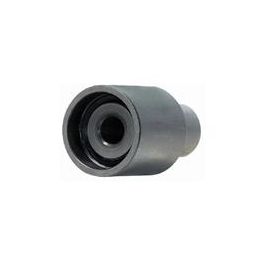

Both petrol and diesel versions are also available with DSG ( Direct-Shift Gearbox). This results in more constant power delivery through the rev range, and better fuel efficiency. This system benefits from the pumping efficiency of the supercharger at lower revs and the fuel efficiency of the turbocharger at high revs. The chargers are a single supercharger that disengages after a specified rev-range, at which point charging of the air is handled by a single turbocharger. The new Twincharger (TSI) petrol engine uses Fuel Stratified Injection (FSI), along with a pair of chargers forcing the induction of the air. The 170 PS (125 kW 168 hp) diesel has 350 N⋅m (258 lbf⋅ft) of torque, which is more than the range topping R32. Both are available as 125 kW (170 PS 168 bhp) versions while the diesel also is available as a 140 PS (103 kW 138 bhp) variant in the UK. In September 2005, the Golf Mk5 GT was announced, which featured a choice of either 1.4 L petrol engine in twincharger (TSI) configuration, or a 2.0 litre TDI.
#Vw 2.0 timing belt tensioner manual#
Transmissions include a 6-speed manual or 6-speed DSG. The Golf GTI included a 2.0-litre Turbocharged Fuel Stratified Injection (FSI) engine rated 200 PS (147 kW 197 bhp) at 5100–6000 rpm (240 PS (177 kW 237 bhp) automatic) and 280 N⋅m (207 lbf⋅ft) torque at 1700–5000 rpm. Transmission options include manual, automatic, Tiptronic, and Direct-Shift Gearbox (DSG). Options for engines and transmissions vary from country to country, but the Golf Mk5 is available with 4-cylinder, 5-cylinder, and 6-cylinder petrol engines, and a new Pumpe Duse unit injector Turbocharged Direct Injection (TDI) diesel engine. Its replacement, the Mk6, was moved forward from the previously stated 2009 in Europe to the autumn of 2008, right after its official premiere at the Paris Motor Show in September 2008.

Its cargo volume is roughly 0.7 cubic feet (20 L) greater. It's indicative of the excessive oil use criticism Audi has faced.The Mk5 had revised suspension changes and chassis tuning and increased cargo volume, corresponding to a minor increase in size over the outgoing model. The engine being repaired is actually an Audi Allroad, 2.0-liter TSI, but he says that problem can happen in all longitudinally-mounted Audi engines. In the YouTube video (linked above), the mechanics pull an engine to fix the over-consumption issue. The company also published its solution, saying production would reduce crankcase pressure in models starting in 2013. The 3.0 T TFSI engine in A6, A7, Q7, A4, and S4 models, from 2009 through 2012, were, according to Audi, using too much oil due to internal pressure inside the engine. As per the NHTSA, Audi published a 2012 service bulletin detailing the issue. But this performance machine manufacturer is plagued with excessive oil consumption complaints. Generally, Audi engines function like clockwork. Of course, the Quattro system was a unanimous success, but we shouldn’t forget that the Quattro also boasted one of the finest engines to ever go rallying.Ĭonsumer Reports raised a red flag on the 3.0-liter V6 for consuming "a quart or more" of oil per oil change period. The Audi Quattro is the perfect case in point, but it was its 2.2-liter inline-5 that really helped it get over the line. Perhaps more durable than the actual surface itself. ReliabilityĪnything that was designed for the deepest depths of the world’s craziest off-road tracks is going to be durable. Other significant innovations to the 1980 engine were a turbocharger and an intercooler. This engine remained a 2.1-liter until the introduction of the 1987 Quattro. It also took the 1985 Pikes Peak Hill Climb. This engine went on to rule rally races, winning the championship in 1983. The 1980 Audi Quattro engine premiered at the Geneva Motor Show. Related: How This Audi R8’s Stock Engine Makes 1,800 Horsepower This engine is the reason that the TT RS and RS3 models have become so revered these days, and we sincerely hope the Audi 2.5 TFSI stays around for a long, long time. It’s hard to argue with those that claim that Audi’s 2.5-liter TFSI engine is the best five-cylinder unit: it’s tough, it sounds fabulous, and, above all else, it just loves to keep going all day long. The engine is currently found in the TT RS and the Audi RS 3 models. The slimmed-down size was, in part, achieved by using aluminum engine parts. The 2.5 TFSI is the smallest and most powerful inline-5. In 2010, the engine won accolades being voted the engine of the year, and went on to win it nine times running. It has been powering these German-made cars since 1976. Audi’s success with its 5-cylinder engine has traction.


 0 kommentar(er)
0 kommentar(er)
